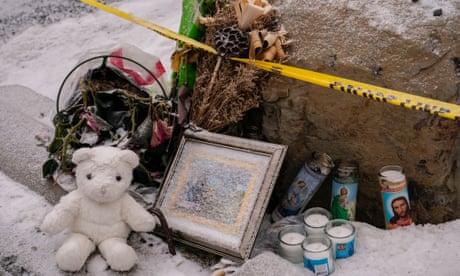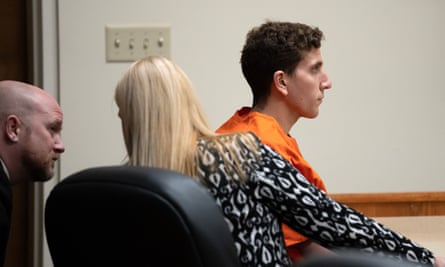For a student of criminology, Bryan Kohberger appears to have been remarkably indifferent to modern methods of detective work.
The accused murderer of four friends at the University of Idaho, who were repeatedly stabbed in their beds with a large knife, was snared by procedures that are the nuts and bolts of police television dramas: cameras tracking his car, cellphone records placing him at the scene, and a search of DNA records collected by genealogy websites that threw up a match with Kohberger’s family.

Yet, according to court statements, despite years of studying police methods, the 28-year-old left a trail of evidence as he allegedly stalked and attacked his victims. He took some decisions, they allege, such as turning his cellphone off during the murders, that only heightened suspicion he was the killer. Police say that Kohberger even returned to the scene of the crime in the hours after the murders.
But even as the police claimed to have got their man, accusing Kohberger of four counts of first-degree murder, key questions remained unanswered. Was there a connection between the criminal justice student’s interest in serial killers and the murders? And why did a surviving housemate wait hours to call the police after apparently encountering the killer outside her room in the middle of the night?
The horrific stabbings of the four young students at their home in Moscow, a small city in the far west of Idaho, in the early hours of 13 November, has shocked America and prompted one of the most intense criminal investigations in Idaho’s history, drawing in dozens of FBI agents.
Kaylee Goncalves and Madison Mogen, both 21, were in the same bed on the third floor when they were repeatedly stabbed with a long knife, according to the coroner’s report.
“They’ve been friends since sixth grade,” Goncalves’s father, Steve, told a candlelight vigil of more than 1,000 people for his daughter. “Every day they did homework together, they came to our house together, they shared everything. And in the end, they died together, in the same room, in the same bed. And it’s a shame, and it hurts.”
Xana Kernodle and her boyfriend, Ethan Chapin, were asleep on the floor below when police allege Kohberger burst in and also killed the two 20-year-olds. A photograph taken hours before their deaths shows four students smiling together, with Mogen sitting on Gonclaves’s shoulders while Chapin has his arm around Kernodle.
Incredibly, another two students, Bethany Funke and Dylan Mortensen, remained unharmed in the house even after Mortensen encountered the killer as he left the building.
Mortensen told police she woke at about 4:00 am and heard noises upstairs. She thought it was one of her housemates playing with her dog but then heard one of the women say: “There’s someone here.”
The student stuck her head out of her bedroom but didn’t see anything. A little later she heard what sounded like crying and a man say: “It’s OK, I’m going to help you.” A security camera on a neighboring home picked up the sound of whimpering, a loud thud and a dog barking.
Mortensen looked out of her bedroom again and this time saw a man in black wearing what looked like a ski mask over his nose and mouth. She described him as having bushy eyebrows.
According to a court affidavit, the student told the police she stood in “frozen shock” as the killer walked past her and out of the back door. She then locked herself in the bedroom.
That leaves one of the great mysteries of the case. Why did neither Mortensen nor Funke immediately call the police? It was nearly another eight hours before one of them dialed 911 to request help for “an unconscious person.”
More than 60 FBI agents were eventually called in to help investigate the killings. But initially it was left to Moscow’s police department. One of its officers, Corporal Brett Payne, said in a statement that he arrived at the King Road residence at about 4:00 pm.
“As I entered this bedroom, I could see two females in a single bed in the room. Both Goncalves and Mogen were deceased with visible stab woulds,” he said.

Payne spotted a key piece of evidence the killer might have been expected to ensure he took with him.
“I noticed what appeared to be a tan leather knife sheath lying on the bed next to Mogen’s right side.”
The police sent the sheath to the state crime lab.
Meanwhile, detectives scoured video footage from cameras in the area and picked out a white Hyundai Elantra driving past the house three times before stopping on the fourth pass shortly after 4:00 am. The car left 16 minutes later “at a high rate of speed,” according to Payne.
The video footage did not capture the vehicle’s number and police officers in the region were told to keep a lookout for cars that matched the Hyundai’s description. Two weeks after the killings, an officer spotted the car in Pullman, a 15-minute drive across the state border from Moscow. It was parked outside the residence of a student at Washington State University – Kohberger.
When detectives looked at the picture on his driving licence they noted the bushy eyebrows.
Investigators were also interested in Kohberger’s academic history. He had completed a master’s degree in psychology and criminal justice at DeSales University, a Catholic institution in his home state of Pennsylvania, in the summer. There he studied under Katherine Ramsland, a forensic psychologist whose books include an account of her long correspondence with one of the U.S.’s most infamous serial killers, Dennis Rader, known as the BTK, or “bind, torture, kill” murderer.
In the autumn, Kohberger began a PhD at the criminal justice and criminology department at Washington State. Fellow students said he showed a particular interest in serial killers.
But Kohberger was also interested in more mundane aspects of police work. Not long after beginning his course in Pullman he applied for an internship at the local police department, the same one that was now part of the murder investigation, saying that he was interested in helping rural police departments collect and analyse data.
The police also noted that Kohberger returned to classes after the killings. The New York Post reported that he sat silently through discussion among fellow students about the Moscow murders.
Even though police had identified the car, they did not seize it. In December, Kohberger’s father flew out to join his son for a road trip back to the family home in Pennsylvania in the same vehicle. The pair were stopped twice by Indiana police for minor driving offenses on the same day. Police body-camera footage shows Kohberger in the driver’s seat with his father next to him.
Meanwhile, FBI investigators trawled through Kohberger’s cellphone records and discovered that he turned it off shortly before the attack, perhaps thinking it would help him to avoid detection. The phone springs to life again at 4:48 am on a road out of Moscow.
The records also showed that Kohberger was in the area near the house at least a dozen times in the months before the attack, usually in the early morning or late evenings. Investigators said they were examining whether he “conducted surveillance on the King Road residents and was in contact with any of the victim’s associates before or after the alleged offense.”
There was one other detail that struck investigators. Their suspect had apparently returned to the vicinity of the crime about five hours later and before the police were called.
The public was told none of this, and what appeared to be the slow pace of the investigation frustrated the parents of the victims. Three weeks after the killings, Goncalves’s father began to publicly question whether the Moscow police were up to the task of finding the murderer. Some students left town as the mystery around the killings grew, fearing that a serial killer was on the loose.
But away from the public eye, investigators were certain they were closing in on their man.
The Idaho state laboratory found a DNA sample on the sheath which it sent on to the FBI’s genetic genealogy branch. The FBI trawled through public databases until a match led to the Kohberger family.
On 27 December, undercover agents seized rubbish from the family home in Chestnuthill Township, Pennsylvania, to scour for matching DNA. The FBI lab made a 99.98% match between Kohberger’s father and the sample on the knife sheath.
Undercover investigators watched their suspect for days until, at 1:45 am on December 30, the police smashed their way through windows and doors into the Kohberger house to make the arrest.
At a court appearance in Moscow on Thursday, Kohberger said little except to acknowledge that he potentially faces the death penalty if convicted. The accused man’s lawyer said his client “looks forward to being exonerated.”
Summary
The families of their victims, along with the rest of America, now await answers to the biggest question of all. Why?

